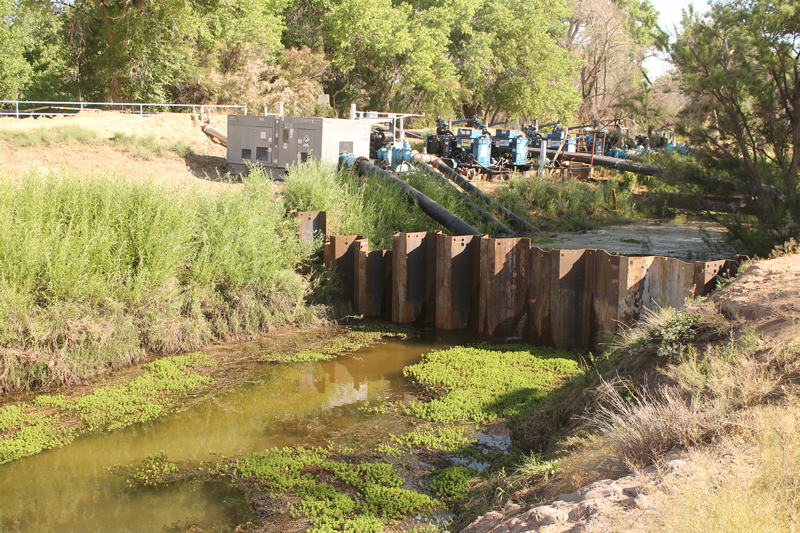LOS LUNAS — Work has begun to repair the culvert under N.M. 6 in the village of Los Lunas where erosion and the collapse of a section of sidewalk occurred in May.
The existing 54-inch corrugated metal culvert that runs under N.M. 6 — Main Street — on the east side of the Los Lunas river bridge will be replaced with a 72-inch diameter reinforced concrete pipe, said Kimberly Gallegos, the New Mexico Department of Transportation District 3 public information officer.
On Saturday, May 13, around 10 p.m., a sinkhole formed due to erosion around the culvert, which caused a section of sidewalk and dirt shoulder on the north side of the street to collapse.
The collapse occurred where the Lower Peralta Drain culvert passes under the street east of the Rio Grande. Water in the drain had been extremely high due to unusually high flows in the Rio Grande.
When the sidewalk collapsed, Sergio Marquez, 40, of Los Lunas, plunged into the fast-moving water in the drain.
He was rescued thanks to the efforts of passers-by and his son, who was with him on their regular bike ride.

Julia M. Dendinger | News-Bulletin photo
Large pumps pull water out of the Lower Peralta Drain to dewater the area that collapsed under a sidewalk on the east side of the Los Lunas river bridge.
The incident in May has spurred NMDOT to evaluate other culverts it’s responsible for along the Rio Grande, especially along the river from near Bernalillo south to Socorro, according to an Albuquerque Journal article by Colleen Heild, published on Sunday, July 9.
New Mexico Department of Transportation drainage bureau chief Burke Lokey told Heild at the time of the incident in Los Lunas, the DOT had been two years into a three-year project to inventory all the state’s culverts, which could number as many as 65,000 by the time all are tracked.
“I know it’s hard to believe the DOT doesn’t know where its own culverts are,” said Lokey, who became bureau chief in 2019. So far, the state has identified 30,000 or 40,000 separate points and is developing a risk rating system depending on their condition.
After the May 13 incident, the DOT issued a $1.5 million emergency contract to repair the culvert underneath the sidewalk. The original metal culvert was some 70 years old, with 30-year-old extensions on both ends.
With high river flows and unusually high groundwater levels in the vicinity, the culvert is actually lower than the groundwater levels right now, Lokey said, “and that’s a big part of the problem. We think that’s part of what happened with N.M. 6.”
Crews have been de-watering the area to isolate the failed culvert. A battery of pumps has been pumping water that’s continuously flowing. The pumps are dumping the water over a levee and into the Rio Grande.
The maximum life of a culvert that small is about 50 years, but at that size “if it fails then you develop a big enough void under the roadway that you’ll have that kind of sinkhole condition,” Lokey said.
Concrete culverts will last up to 100 years.
“But a lot of our corrugated metal pipes … we start to see significant problems with them after 30 years. And an estimated 70 percent of the DOT’s culvert inventory is corrugated metal pipes,” he said.
“We need to do this inventory and get the entire system set up so that we know where we need to prioritize our dollars.”
Replacement of the Los Lunas culvert is expected to be completed by late fall of this year, Gallegos said.
The total project cost will be about $3.3 million, which NMDOT will fund on its own, she said, with the village responsible for any repair costs to its water and sewer lines that run under the bridge.
Shortly after the sidewalk collapsed, village of Los Lunas water department personnel made the decision to shut off the 16-inch water line running under the bridge, said Michael Jaramillo, public works director for the village.
The water line wasn’t damaged, but was shut off to prevent more issues, Jaramillo said, noting if the line had broken the erosion would have become much worse.
The village completed its north waterline loop in 2022, and was able to bring it online in May to provide water to residents and businesses east of the bridge while the line under the bridge is off. Water delivery has been going through the north loop since the collapse.
High flows in the Rio Grande pushed large volumes of water into the Lower Peralta Riverside Drain east of the river, which is its purpose. The drains serve as a catchment for river water during high-flow years, and help prevent water from flooding further into the valley. The seepage is carried south to beyond the city of Belen.
While the riverside drain is part of the Middle Rio Grande Conservancy District’s infrastructure, district CEO and chief engineer Jason Casuga said the culverts under the roadway have been NMDOT’s to maintain since 1989, when the highway was widened to four lanes.
Julia M. Dendinger began working at the VCNB in 2006. She covers Valencia County government, Belen Consolidated Schools and the village of Bosque Farms. She is a member of the Society of Professional Journalists Rio Grande chapter’s board of directors.

















